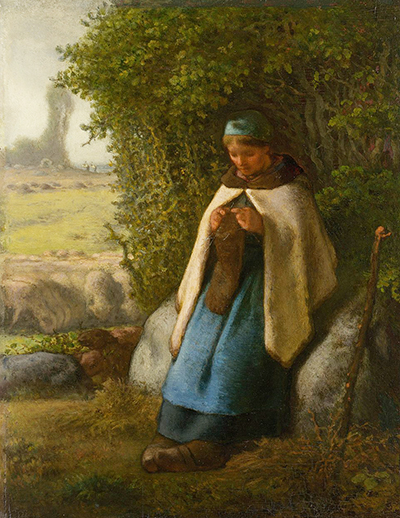Shepherdess Seated on a Rock is an 1856 oil on wood painting by Jean Millet. Millet was a leader of Barbizon School, which focused on realism and is also known for his pictures of peasant Famers and also exposing landscape.
In Shepherdess Seated on a Rock, the shepherdess is seen wearing a linen hood and a white cloak that were common of the peasant women in the society of north-central France. It is worth noting that Miller painted this picture which was an almost an identical version of another one. Millet had almost finished painting of the same subject in 1856 when a young artist admired it in his studio and asked to buy it. Because the initial work was promised to a patron, Millet made a replica and that is how the two identical work exists.
In the paint, the shepherdess sheep are seen slightly from where she is seated, knitting. They occupy the middle, left side of the paint. Further into the background are two figures of people seen heading into the left side of the artwork into the oblivion. This creates an atmosphere of mystery as the viewer's mind is forced to think where the figures are headed.
Besides where the shepherdess is seated is her rod, at the extreme right side of the paint, probably used for controlling the flock of sheep. Behind her is a thick thicket, depicting the area where the animals are feeding is an open unattended piece of land. Some dark heavy clouds are partly forming in the sky, indicating possible showers of rain, but the shepherdess is unbothered by this as her eyes are fixed on the knitting. This paint can be said to be different from other Millets' work in that it was somehow turning away from his idealized pastoral subjects, into a more detailed realistic and personal approach.
Millet was first influenced into painting by Bon Du Mouchel, whom he studied under while in Cherbourg. He also befriended Constant Troyon, Narcisse Diaz, Charles Jacque, and Theodore Rousseau who would closely become associated with the Barbizon school.
Among his legacy includes, His work The Angelus, was reproduced severally in the 19th and 20th century. Salvador Dali was particularly fascinated by this work and wrote much analysis of it. He believed that it held a secret massage of sexual aggression. His work L`homme a la houe also inspired a popular poem by Edin Markham.
Other painting work by Millet are Portrait of Louise Alexandre Marolles of 1841, Haystacks Autumn of 1874, The Coast of Greville, The Goose Girl of 2863, and Potato Planters of 1861 among many more.




